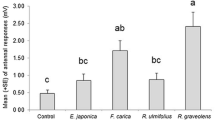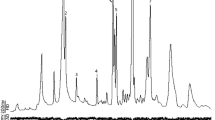Abstract
Codling moth females (Cydia pomonella, Lepidoptera: Tortricidae) (CM) usually lay single eggs and have a tendency to disperse. In a first experiment we observed that single females exposed to 20 apples distribute their eggs regularly among apples, suggesting a dispersive oviposition behavior. In a dual-choice situation, isolated females avoided oviposition on areas of cardboard treated with a methylene dichloride egg extract at the dose of ca. 1.0 egg equivalent/cm2. A strong avoidance was obtained in response to a 20-fold dose, which was accompanied by a significant reduction of total oviposition. Seven major compounds found by GC analyses in the methylene dichloride extract of 2 to 3-day-old eggs were saturated or unsaturated C14-C18 straight-chain fatty acids: myristic acid, palmitic acid, palmitoleic acid, stearic acid, oleic acid, linoleic acid, and linolenic acid. This was confirmed by GC-MS analysis of an extract made by ethyl ether. Smaller amounts of three methyl esters were also identified as methyl myristate, methyl palmitate, and methyl stearate. A blend of the seven fatty acids (FA) mimicked rather well the avoidance provoked by the extract, and this avoidance was confirmed by choice between treated and untreated fruits by single females. The treatment of apples with the 7FA mixture induced an aggregative distribution of the eggs among apples. We also found that the amounts of fatty acids harvested in the extract depend on the egg age. Amounts of fatty acids increased until eggs were 4 days old and then decreased before hatching. In this paper we discuss the possible role of simple molecules, such as fatty acids and their esters, as semiochemicals indicative of juvenile tissues.
Similar content being viewed by others
References
Anderson, P. 1986. Oviposition-deterring pheromones in insects. Introd. paper 45, Lund University. 19 pp.
Blaakmer, A., Stork, A., Van Veldhuizen, A., Van Beek, T.A., de Groot, A.E., van Loon, J.J.A., andSchoonhoven, L.M. 1994. Isolation, identification and synthesis of miriamides, new host markers from eggs ofPieris brassicae.J. Nat. Prod. 57:90–99.
Chessel, D. 1978. La description non-paramétrique de la dispersion spatiale des individus d'une espèce, pp. 45–135.in J.M. Legay and R. Thomasone (eds.). Biométrie et Ecologie. INRA.
Chew, F.S., andRobbins, R.K. 1984. Egg laying in butterflies, pp. 65–79,in R.I. Vane Wright and P.R. Ackery (eds.). The Biology of Butterflies. Academic Press, New York.
Ferro, D.N., andHarwood, R.F. 1973. Intraspecific larval competition by the codling moth,Laspeyresia pomonella.Environ. Entomol. 2:783–789.
Gabel, B., andThiéry, D. 1992. Biological evidence of an oviposition-deterring pheromone inLobesia botrana Den. et Schiff. (Lepidoptera, Tortricidae).J. Chem. Ecol. 18:353–358.
Gabel, B., andThiéry, D. 1994. Semiochemicals fromLobesia botrana eggs deter oviposition by the codling moth (Cydia pomonella).Europ. J. Entomol. 91:353–359.
Geier, P.W. 1963. The life history of codling moth,Cydia pomonella (L.) (Lepidoptera: Tortricidae), in the Australian capital territory.Aust. J. Zool. 323–367.
Guennelon, G., Audemard, H., andFrémond, J.C. 1981. Progrès réalisés dans l'élevage permanent du carpocapse (Laspeyresia pomonella L.) sur milieu artificiel.Agronomie 1:59–64.
Hurter, J., Boller, E.F., Städler, E., Blattman, B., Bosshard, N.U., Buser, H.R., Damm, L., Kozlowski, M.W., Schöni, R., Raschdorf, F., Dahinden, R., Schumpf, E., Fritz, H., Richetr, W., andSchreiber, J. 1987. Oviposition-deterring pheromone inRhagoletis cerasi L.: Purification and determination of the chemical constitution.Experientia 43:157–164.
Hwang, Y.S., Schultz, G.W., andMulla, M.S. 1984. Structure-activity relationship of unsaturated fatty acids as mosquito ovipositional repellents.J. Chem. Ecol. 10:145–151.
Imai, T., Kodoma, H., Chuman, T., andKohno, M. 1990. Female-produced oviposition deterrents of the cigarette beetle,Lasioderma serricorne (F.) (Coleoptera: Anobiidae).J. Chem. Ecol. 16:1237–1247.
Jackson, M.D. 1979. Codling moth egg distribution on undamaged apple trees.Ann. Entomol. Soc. Am. 72:361–368.
MacLellan, C.R. 1962. Mortality of codling moth egg and young larvae in an integrated control orchard.Can. Entomol. 94:655–666.
Messina, F.J., andRenwick, J.A.A. 1985. Ability of ovipositing seed beetles to discriminate between seeds with differing egg loads.Ecol. Entomol. 10:225–230.
Prokopy, R.J. 1981. Epideictic pheromones that influence spacing patterns of phytophagous insects, pp. 181–213,in D.A. Nordland, R.L. Jones, and W.J. Lewis (eds.). Semiochemicals: Their Role in Pest Control. John Wiley & Sons, New York.
Putman, W.L. 1963. The codling moth (Carpocapsa pomonella L.): A review with special reference to Ontario.Proc. Entomol. Soc. Ont. 93:22–59.
Rickli, M., Guerin, P.M., andDiehl, P.A. 1992. Palmitic acid released from honeybee worker larvae attracts the parasitic miteVarroa jacobsoni on a servosphere.Naturwissenschaften 79:320–322.
Roitberg, B.D., andProkopy, R.J. 1982. Resource assessment by adult and larval codling moths.N.Y. Entomol. Soc. 90:258–265.
Roitberg, B.D., andProkopy, R.J. 1987. Insects that mark host plants. An ecological, evolutionary perspective on host-marking chemicals.BioScience 37:400–406.
Rothschild, M., andSchoonhoven, L.M. 1977. Assessment of egg-load byPieris brassicae (Lepidoptera: Pieridae).Nature 226:352–355.
Schoonhoven, L.M. 1990. Host-marking pheromones in Lepidoptera, with special references to twoPieris spp.J. Chem. Ecol. 16:3043–3052.
Thiéry, D., andGabel, B. 1993. Interspecific avoidance of egg-associated semiochemicals in four tortricids.Experientia 49:998–1001.
Thiéry, D., andLe Quéré, J.L. 1991. Identification of an oviposition deterring pheromone in the eggs of the European corn borer.Naturwissenschaften 78:132–133.
Thiéry, D., Gabel, B., Farkas, P., andPronier, V. 1992. Identification of an oviposition-regulating pheromone in the European grapevine moth,Lobesia botrana (Lepidoptera: Tortricidae).Experientia 48:697–699.
Trouiller, J. 1993. La communication chimique intra- et interspécifique chez l'abeille: Relations abeille Varroa, couvain ouvrière et reine ouvrière. Thèse Doc. Univ., University of Paris 7, 146 pp.
Wood, T.G. 1965. Field observations on flight and oviposition of codling moth and mortality of eggs and first-instar larvae in an integrated control orchard.N.Z. Agric. Res. J. 8:1043–1059.
Author information
Authors and Affiliations
Rights and permissions
About this article
Cite this article
Thiéry, D., Gabel, B., Farkas, P. et al. Egg dispersion in codling moth: Influence of egg extract and of its fatty acid constituents. J Chem Ecol 21, 2015–2026 (1995). https://doi.org/10.1007/BF02033859
Received:
Accepted:
Issue Date:
DOI: https://doi.org/10.1007/BF02033859




